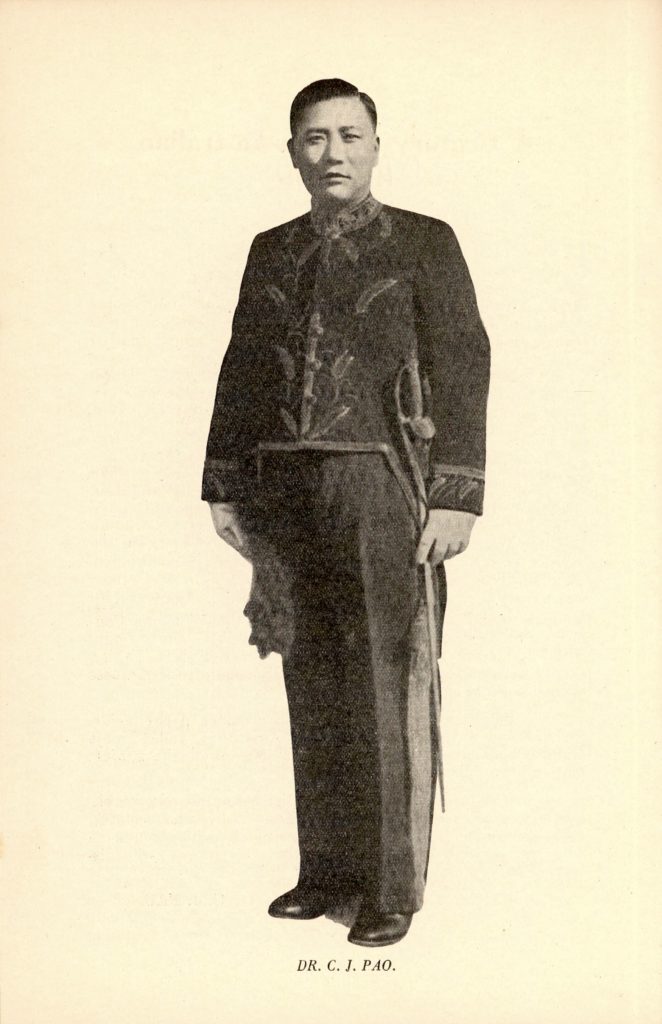Chinese Immigration – Provisional Belonging
Willa McDonald, Sydney

Figure 2: Pao, Chun-Jien, portrait from his pamphlet (1938). A Century of Sino-Australian Relations. Sydney: John Sands, p.6.
Image courtesy of National Library of Australia, https://catalogue.nla.gov.au/Record/1639912.
By 1938, Sydney, a busy trading port, had become the most populous centre in Australia for Chinese residents, with the ongoing primacy of the city nationally recognised by the relocation of China’s consul-general from Melbourne to Sydney a decade earlier (Fitzgerald, 2008). At the time of the Sesquicentenary, Pao Chun-Jien was Consul General (Figure 2). His pamphlet, produced against this background of simmering racial inequality, was written to “enhance a closer Sino-Australian relationship” with the ostensible purpose of boosting trade between the two nations (Pao, p. 1). According to its foreword, only a limited number of complimentary copies were made available which were no doubt distributed to dignitaries and other important participants in Sydney for the Sesquicentenary celebrations, as well as to the press. Copies could also be bought with profits “remitted for the alleviation of the distressed non-combatant population of China”.
China was deep at war with the Japanese at the time Pao was writing. Not surprisingly, the pamphlet emphasises China’s devotion to peace and international co-operation. Pao takes pains to counter Australian-held stereotypes of the Chinese, while outlining the history of Chinese migration to Australia. The Chinese had been influential on Sydney from the beginning, with one of the reasons for the establishment of the First Settlement by the British to extend links with Canton (Guangzhou), the major trading port city of south east China (Fitzgerald, 2008). While some Chinese were brought to Australia as indentured labour, many more came out in the Gold Rush years from the 1850s. As gold petered out, they largely congregated in Sydney, often unable to return to China because of unfair and sometimes punitive immigration agreements, but were prohibited by racism from participating fully in Australian society (Fitzgerald, 2008). Pao’s pamphlet takes up the story, pointing to the contribution the Chinese made to the development of the Australian nation:
…I can assert that the Chinese did help the Australians in developing this country, in overcoming Nature’s obstacles, in subduing the terrors of the trackless bush and scrub. They helped to cultivate the land, open mines, build highways and railways, while they also took part in navigation and other means of communication…
(Pao, p. 6)
Between flattering references to Australia’s future as a great nation, the pamphlet is direct in addressing Australian racism towards anyone of Chinese ethnicity; promoting China’s non-aggressive stance; arguing the need for a treaty of friendship between the two countries; urging the relaxation of the White Australia Policy (which had been in place following Federation in 1901), suggesting the establishment of intellectual and cultural exchanges and, most of all, advocating for greater economic co-operation and trade. To Pao, economic co-operation was the path to peace:
To attain the status of Great Power, Australia needs only the reciprocal trade of china, a treaty of friendship and non-aggression with the same country, and the confidence that this Sino-Australian co-operation in itself is sufficient to maintain both nations at a high level of economic development (Pao, p. 29).
End of Part 2…
To be continued in an upcoming post on this blog: Entangled History and Transnational Context: Part 3
See also Entangled History and Transnational Context: Part 1